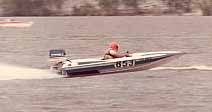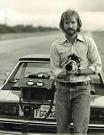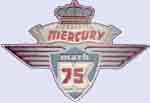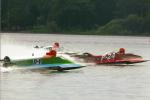Feel free to quote me Joe, but I'm not sure that was the best way.

It was the only way I figured I could do it having never driven a boat rigged that way before. I can't remember exactly how the steering was now, but it was very direct. I could not have turned one of my boats that way unless I had one of those "knuckle knockers" or whatever the 50's high school hot rodders had on the steering wheels of their 57 Chevy's. It would probably take a turn and a half of the steering wheel or so in one of my boats. I'm thinking that there was no pulley on the steering bar. What ever you spooled up on the drum turning left was directly fed back to the steering bar on the right without having been run through a pulley and tied off at the cockpit. This would be direct steering like with a rope tied to the front axle of a homemade derby car. I might be wrong about that setup, and maybe Steve Litzell could correct it, but the technique I used to get around a single pin in a narrow chute seemed to work O.K.
As far as the Konig goes, I tried cleaning the outside with different chemicals, but the rough casting and decades of castor oil baked and gummed in made it very hard. I didn't want to polish it smooth and I didn't want to disassemble it and soak it in some stuff Paul Christner told me about that would do the job. Then I thought that if I just cleaned the worst bit of it off and left the castor oil down in the niches, crannies, and lowest parts of the casting then there would still be a little bit left of Marshall Grant, my racing team, Harry Bartolomei, and the other owners left on it. I painted the stacks and elbows black, as well as the original style coils. I cleaned up the tower housing, but I have not found the seals and bearings for the lower unit yet. I got busy in the oilfield and have not yet gotten a bracket made to hang on the wall. I have the powerhead stored in my darkroom to keep it out of the dust. I do need to get the bracket made so I can put it all together.
You know Joe, I have thought about some things we could have done back in the day had we thought about it. A lot of the ideas have come from BRF members. Sometimes they say things that make you think, and you could have applied it to something you were having problems with. I still have a horsepower producing idea in my mind that would be legal and I think would significantly increase horsepower, but no one on our team had the ability or equipment to build it, and we didn't trust any outside source. It was toward the end of our racing career so we never tried it on boats, although it worked well in an oilfield application.


 Thanks:
Thanks:  Likes:
Likes: 




 Reply With Quote
Reply With Quote

 It was the only way I figured I could do it having never driven a boat rigged that way before. I can't remember exactly how the steering was now, but it was very direct. I could not have turned one of my boats that way unless I had one of those "knuckle knockers" or whatever the 50's high school hot rodders had on the steering wheels of their 57 Chevy's. It would probably take a turn and a half of the steering wheel or so in one of my boats. I'm thinking that there was no pulley on the steering bar. What ever you spooled up on the drum turning left was directly fed back to the steering bar on the right without having been run through a pulley and tied off at the cockpit. This would be direct steering like with a rope tied to the front axle of a homemade derby car. I might be wrong about that setup, and maybe Steve Litzell could correct it, but the technique I used to get around a single pin in a narrow chute seemed to work O.K.
It was the only way I figured I could do it having never driven a boat rigged that way before. I can't remember exactly how the steering was now, but it was very direct. I could not have turned one of my boats that way unless I had one of those "knuckle knockers" or whatever the 50's high school hot rodders had on the steering wheels of their 57 Chevy's. It would probably take a turn and a half of the steering wheel or so in one of my boats. I'm thinking that there was no pulley on the steering bar. What ever you spooled up on the drum turning left was directly fed back to the steering bar on the right without having been run through a pulley and tied off at the cockpit. This would be direct steering like with a rope tied to the front axle of a homemade derby car. I might be wrong about that setup, and maybe Steve Litzell could correct it, but the technique I used to get around a single pin in a narrow chute seemed to work O.K.







Bookmarks